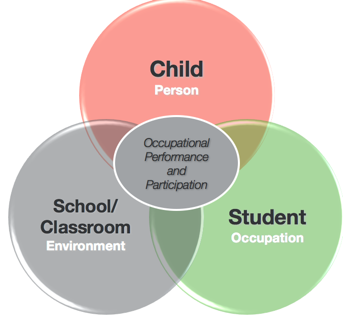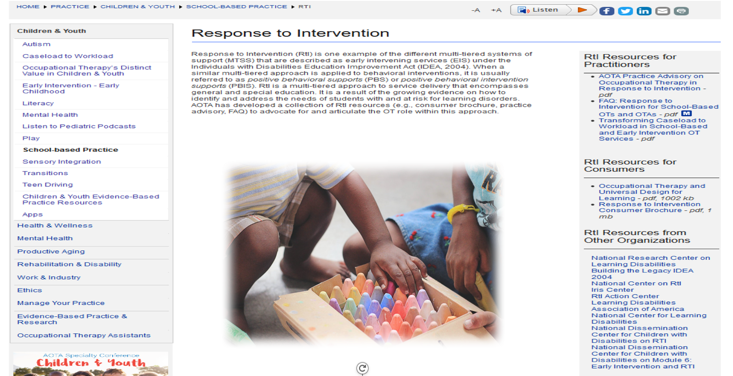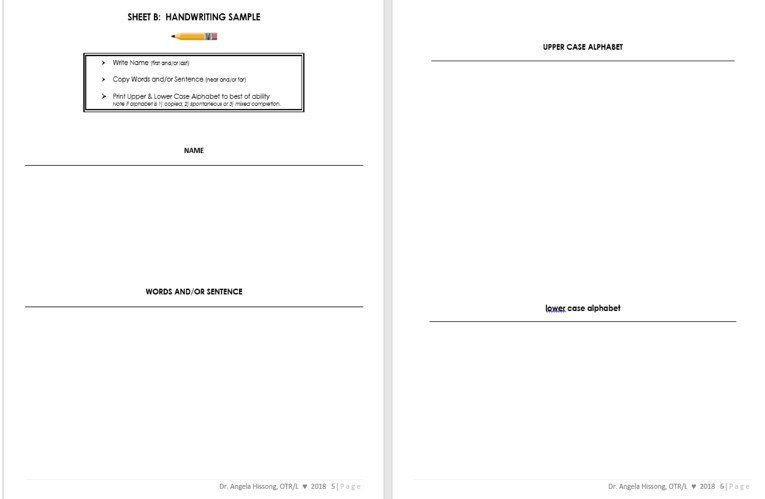Angela: Welcome everyone. Let's get started.
Story Behind the eOTe
I developed the eOTe for 4 reasons:
- As a school-based practitioner & educator, a need for a mindful occupation-based OT screening tool for a younger child (preschool-primary).
- A screening tool that is helpful to OT Practitioners or the OTA/OT student during an FW I/II experience in assessing the strengths and needs of a child - based from the OT Practice Framework, 3rd Edition (2014) and PEOP Model (2005).
- The desire to assist educators, parents, caregivers, and student-learners with educationally-related activities, tools, and modalities – grounded in occupational performance, engagement in meaningful occupation & participation.
- To present a portfolio of occupation-based activities for the teacher & caregivers to utilize with children and/or child…soon after I spent time with the child(ren).
As a school-based practitioner and an educator, I needed a more mindful occupation based OT screening tool for the younger child, preschool to primary age, to use in my practice. I have been putting this screening tool together since the early 90s, and it has evolved over that time. We will be using it this fall with OTA students to do an experiential experience with a preschool classroom and an after-school program with school-aged children.
The screening tool is helpful for OTs, OTAs, or the OT student during a fieldwork level one or two experience or in practice. It helps to assess the strengths and needs of a child based on the OT Practice Framework (3rd edition). It also incorporates the PEOP Model, which we will go over in detail.
I also had a desire to assist educators, parents, and caregivers with educationally related activities, tools, and modalities that were grounded in occupational performance and meaningful engagement in occupation and participation as shown in the evidence.
The fourth reason was that I wanted to present a portfolio of occupation-based activities for the teacher and/or the caregivers to utilize with the children or the child soon after I spent time with them. I did not want to go in and do a screening and not have something to give to them.
Dovetailing the Evidence with Practice
It is very important as we know to have evidence dovetailed in with practice and form a conceptual framework for the eOTe.
- Therapeutic Use of Self
- Mindfulness
- PEOP Model
- OT Practice Framework
- Occupational Profile
- Engagement in Occupation
The therapeutic use of self is the ground root for the Occupational Therapy Practice Framework (OTPF). I have also been looking and working with mindfulness since the late 90s. This was really important to me, and I will share a little bit about that in the next slide. The PEOP model and The OT Practice Framework also serve as frameworks for the eOTe.
Therapeutic Use of Self
As we know, the core of occupational therapy is the therapeutic use of self. The use of self as a therapeutic agent is integral to the practice of occupational therapy and is used in all interactions with all clients. This is stated in the OT Practice Framework, 2014 edition. As we know, they are working on that right now. There is going to be a 4th edition coming up soon. The magic is truly in you. It is really cool to be able to take yourself into the classroom and use your self as the medium with which to work with a student. This also goes for caregivers and teachers.
Mindfulness
The next piece is the use of mindfulness in occupational therapy practice. Again, this has been something I have been utilizing for about 20 years now. This goes hand in hand along with a therapeutic use of self. McAdams (2003) says, "If you want to know me, then you must know my story, for my story defines who I am." Mindfulness helps you to situate yourself a little bit more in mindfulness. If it is something that you have not thought about or something that you want to know a little bit more about, I have a website that I put together about two years ago. I wanted to share that with you because it is a great opportunity to help spread the word and might help you whenever you are in the classroom.
There are two areas. One is mindful collaboration which is very much embedded in occupational therapy. There are some great resources on the website to utilize in therapy practice. The other set of resources focus on the clinician. Practice, especially school-based practice, can be extremely stressful. There are some websites, apps, music, books, mantras, meditations, and TED talks. Feel free to look at that as you like.
Occupational Therapy Practice Framework
The next piece is the framework, The Occupational Therapy Practice Domain & Process, 3rd Edition. Figure 1 shows the OTPF Short Form.

Figure 1. The OTPF Short Form.
I also gave you the PDF, and you can print that out and take a look at that whenever you get a chance. We are looking at all those pieces that are under the education area, as well as the performance skills, performance patterns, activity demands, and client factors. I have operationalized the OT Practice Framework and the PEOP for you. You can certainly share these components with administrators, teachers, caregivers, or whomever if you want to share a little bit more about the process.
Operationalizing the OTPF within the eOTe Portfolio Process
The OT Practice Framework was developed to articulate occupational therapy's contribution to promoting health and participation of people, organizations, and populations through the engagement and occupation. The overarching statement is that we are supporting a child's health and participation in life through engagement in occupation. That describes the domain of occupational therapy in its fullest sense. There are global areas of occupation that we are looking at in the eOTe or in any screening tool you use.
Global Areas of Occupation
Global areas of occupation are:
- Education
- Play
- Exploration
- Participation
- Social Participation
We are looking at education, play, exploration, participation, and social components.
Client Factors
We are also looking at the client factors. Client factors of focus will include but may not be limited to:
- Mental Function: Affective, Cognitive, Perceptual Function
- Sensory Functions
- Neuromusculoskeletal & Movement-Related Functions
This may not be limited to mental function (the affective, cognitive, and perceptual), sensory functions, and neuromuscular and movement-related functions.
Activity Demands
Activity demands are dependent upon the task. These are also important to consider. What are the activity demands? Do we need to grade up? Do we need to grade down? What does the child actually need?
Performance Skills
The performance skills, which are the abilities of the child to engage in the meaningful occupation of work & play as a student, may include:
- Motor & praxis skills
- Sensory-perceptual skills
- Emotional regulation skills
- Cognitive skills
- Communication & social skills
The specific performance skills which are the abilities of the child to engage in the meaningful occupation of work as a student and play as a student may include or do include, motor and praxis skills, sensory-perceptual, emotional regulation, cognitive skills, and communication and social skills.
Performance Patterns
The performance patterns of the child will focus on:
- Habits
- Routines
- Rituals
- Roles
We are also looking at what the child's habits, routines, ritual, and roles are. Which ones support them in the educational environment and which ones do not. We also need to look at sensory regulation, modulation, and so forth to get them to try things a little bit differently.
Contextual and Environmental
We are also focusing on the contextual and environmental strengths and challenges that impact their involvement.
- Cultural
- Personal
- Temporal
- Virtual
- Physical
- Social
We need to look at the child's cultural components. What are the personal components like their performance skills and the performance patterns? What is the timing? Is it a good day or a bad day? There are so many virtual components to a child's day now. What are those pieces that we need to look at? We also need to look at the physical and the social components.
Further Operationalizing eOTe within the OTPF Framework (2014, p. S10)
Evaluation and Screening
- Occupational Profile
- Analysis of Engagement in Occupations & Occupational Performance
Intervention
- Intervention Plan
- Intervention Implementation
- Intervention Review
Outcomes
- Supporting health & participation - of the child- in Life through Engagement in Occupation
Two primary focuses of the eOTe are the screening and the outcomes. You can use the components of the eOTe in intervention, but for the most part, I am going to talk about screening and outcomes today.
More Distinct Areas Of Occupation & Performance Addressed with the Child
If you need more evidence and/or you need to provide a little bit more information to folks that you are working with, these are more distinct areas of occupation and performance addressed with the child.
- ADLs & IADLs
- Positioning & Mobility
- Play within Environment
- Learning everyday occupations in the educational environment
- Regulation of physical sensory input/output
- Organization of space, time & material management
- Social interaction
- Limited fine-motor & pre/handwriting, coloring, scissoring, etc.
- Emotional Regulation Skills- expressing emotions or interpreting social cues
We need to look at ADLs, IADL's, positioning and mobility, play within the environment, everyday occupations in the educational environment, and regulation of physical and sensory input and output. It is also important to look at the organization of their time and space.
The Occupational Profile
AOTA put together a great practice piece for us to use. The occupational profile is a component of the eOTe, and it provides an understanding of a client's perspective and background. The child's perspective is very important to this screening. We need to make sure that the child, the caregiver, the teachers, and the professionals all understand this. During the process of collecting this information, we need to identify priorities and the desired target outcomes and the meaning for them in the educational environment. We need to remember that only the clients can identify the occupations that give meaning to their lives.
The eOTe was put together to look at what the child needs. At AOTA, they put together some examples of the occupational profile utilized within a school-based practice. There is a template that you can access on AOTA and get it anytime. For example, they have, "How to Write a Client's Occupational Profile." There are also examples of actual clients and a few that are school-based. There are two school-based and then one that is a 2 1/2-year-old pediatric client.
Engagement in Occupation (OTPF, 2014, p. S4)
The performance of occupations is a result of choice, motivation, and meaning within a supportive context environment. This is again looking at the child's experience. It involves the interaction between our mind, body, and spirit. Bringing in that mindfulness piece is really important. What do they like? Do they like snow? Do they like rain? Dogs? Tractors? Ninja warriors? What is their thing? Occupational therapy intervention focuses on creating or facilitating opportunities to engage in occupations that lead to participation in desired life situations (AOTA, 2008).
PEOP Model Allows for a Mindful View of the Child in the Educational Environment
- Person
- Child
- Environment
- School/Classroom
- Occupation
- Student
- Performance & Participation
- What does the child need to do?
- How is the child engaging – mind, body & spirit?
- How can we assist performance & participation?
We are taking a look at all of this together (Figure 2).

Figure 2. The PEOP Model. (Christiansen, Baum & Bass-Haugen, 2005)
Under performance and participation, there are some questions to ask. What does the child need to do in the classroom or in their environment? How is the child engaging? How can we assist the child with performance and participation to the best of their ability?
MTSS and RTI
Dr. Melanie Wheeler, in Day 5 of this series, will go into much more detail about MTSS and RtI, but I did want to situate to the eOTe within these tiers. I am going to take you through the eOTe, and then at the end, we are going to talk a little bit about how it fits into the Tier I, which is the research-based core instruction. I am going to give you most of all the evidence that you need for that to happen. In Tier II, there are the targeted interventions. Remember what I said in the beginning, the eOTe is not only used for intervention, but it can be a starting point or a bouncing off point to look at full evaluation and then full intervention with a child. It may give you some clues about what interventions to use.
This is another AOTA document in Figure 3.

Figure 3. RtI on AOTA.
We are typically looking at Tier I and the Tier II levels of support. Tier I is for 80 to 90% of students, and then Tier II is for 10 to 15%. The eOTe really fits in mostly to Tier I, but it can be used in Tier II. And, it is extremely helpful if you go to a Tier III evaluation to help you understand what that child may need within that classroom.
The eOTe Components
- eOTe Portfolio Activity Sheets (PDF Included)
- eOTe Box with Object-Performance Grid (PDF Included)
- AOTA Occupational Profile (PDF & link included)
- OTPF & PEOP Ponder-Points …pause with the information.
- Collection of Artifacts from Teacher(s)
- SwifteOTe Project Box (intervention, examples provided)
This is probably what you were mostly wondering about instead of all that evidence-based stuff. This is the fun part. You have full handouts of these.
The eOTe Portfolio Activity Sheets
I think many people associate an owl with education. Figure 4 shows the graphic I made.

Figure 4. The eOTe graphic.
Whenever you see this symbol, this indicates the paper components of the eOTe. You will see more pictures of that as we move through. The eOTe portfolio activity sheets. Let's take a look at these. If you can print these out, it might be a little bit easier to see that on the computer screen. There are 14 pages to this. I introduce this as the early eOTe exposure screening, and I call it a mindful OT screening. It is an occupation based portfolio. The eOTe Portfolio Activity Sheets

Figure 4. The eOTe Screening and Intervention form. (PDF in handouts).
It looks at student factors, AOTA Occupational Profile, prewriting shapes, handwriting performance, cutting, coloring, visual perceptual tasks, functional materials management, ADLs, and activity demands. Here are the pre-writing shapes in Figure 5. This is the order of the pre-writing shapes. I have also given you a description at the top.

Figure 5. Prewriting shapes.
The next component is the handwriting sample in Figure 6. You can use any of this, all of it, or in combination. What can the child do? If the child can not write their name, obviously you are not going to have them write their name. Or, if they cannot write words or sentences, you are not going to have them do that. You also look at the upper case and lower case letter formation. You have them do this on these sheets.

Figure 6. Handwriting sample.
